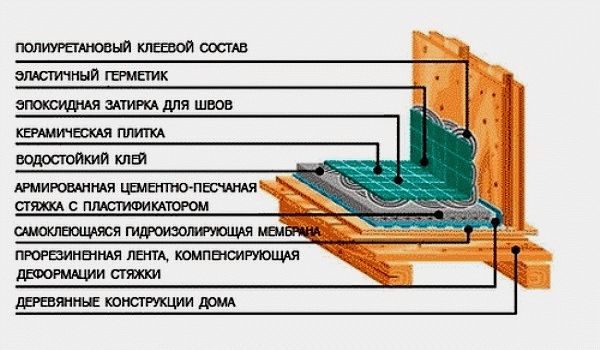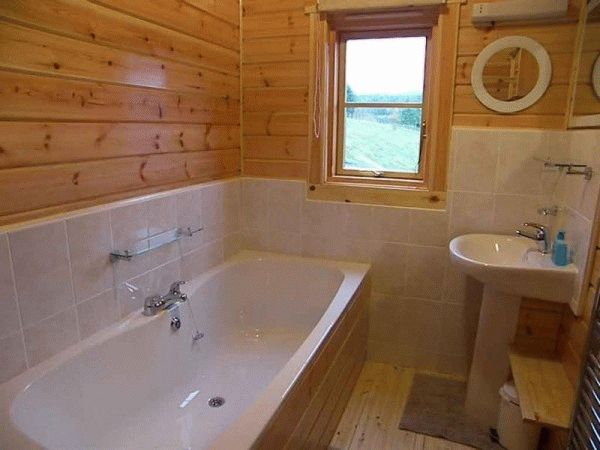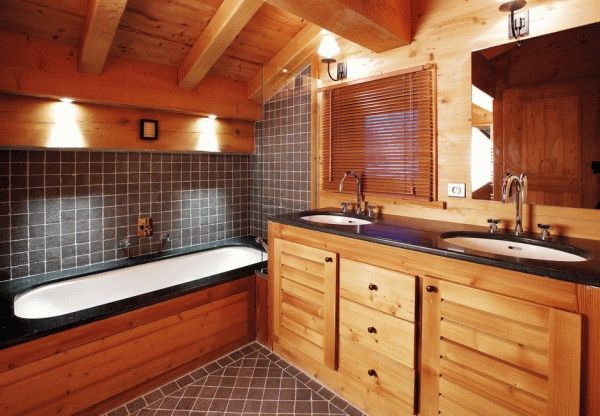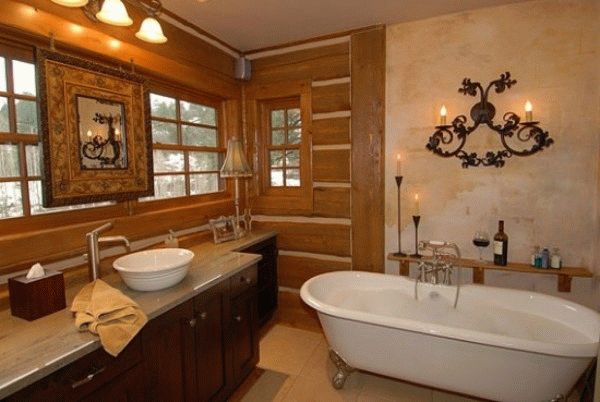How to decorate a bathroom in a wooden house: practical recommendations
A real house made of wood that smells like a forest is very cool, but the question of a room in a wooden house seems problematic. The specifics are such that it would be illogical to lay classic tiles on top of wood - was it worth building a house out of wood to hide the main beauty? Moreover, the material itself is such that laying tiles on top of it is not as easy as it might seem at first glance. However, experts say that you can improve your bathroom even with your own hands. How to do it?
Whatever the owner ultimately decides to decorate the floor, walls and ceiling with, the first thing he will definitely need is waterproofing. Even if all elements of the interior and decoration of the bathroom are adapted to high humidity, it is important not to let it leave the room.
Waterproofing a bathroom in a wooden house depends on whether we are going to leave the walls wooden, or whether there will be some additional finishing on top. If the surface remains in its original state, then there is not much room for maneuver, because all that can be done is to thoroughly saturate the material with antiseptics and moisture repellents.
The procedure will be a little more complicated if finishing is still planned. The main waterproofing usually consists of a two-layer film. Protection against moisture penetration should be located over the entire floor area, as well as along the walls - at least twenty centimeters in height, in order to avoid flooding of the underlying rooms or foundation. The ceiling is usually not subject to waterproofing. A floating sand-cement screed is laid on top of the film, and only after this the final finishing is carried out.

Bathroom finishing
Floor
To finish the floor in the bathroom, it is advisable to think through all the details at the construction stage of the building. The fact is that the bathroom floor ceilings must be reinforced with the help of a larger number of thicker beams than in neighboring rooms, and the floor level should be twenty centimeters lower. After complete finishing, the floor acquires approximately the same height as in the neighboring rooms.
The following finishing materials are used to finish the bathroom floor:
- ceramic tiles, porcelain stoneware, mosaic;
- varnished adhesive stopper;
- moisture-resistant laminate or linoleum;
- moisture-resistant wood species.
Alternatively, you can leave the floors in the bathroom made of the same type of wood from which the building as a whole is built, but then the material should be carefully impregnated with protective antiseptic and moisture-repellent compounds.
Walls
The majority of owners of wooden houses strive to purchase such a building precisely so as not to finish the walls in any way, but to fully enjoy the look and aroma of real wood. The bathroom is no exception, because in this design it can resemble a bathhouse, and in general it looks very colorful and beautiful. As in the case of the floor, the main problem here is waterproofing and protecting the wood from any negative factors such as rotting, fungal infection, soaking, and similar problems.
In theory, of course, the walls can be finished with any common finishing material. True, in this case you should take special care of the built-in waterproofing. Please note that a layer of waterproofing with an additional layer of finishing materials on top of it will certainly reduce the area of the room, which does not always correspond to the wishes of the owner. However, the size of bathrooms in private houses is usually such that there are no problems in installing any desired plumbing fixtures.

It is advisable to consider something as a finishing material that is easy to maintain. The best option is ceramic tiles, but installing them will be expensive and difficult, so it makes sense to consider other materials. At the same time, it is desirable that the walls can “breathe” and that there is normal ventilation in the room, allowing moisture not to accumulate, since no material can usually withstand such a test for a long time.
Ceiling
The ceiling often has fewer responsibilities than any other surface in the same room. Direct splashes usually do not fall on it, since it is located far from all kinds of plumbing fixtures, and with well-designed ventilation, fumes do not accumulate under it for a long time. However, it is also very important to think about the arrangement of the ceiling.

The owner may well leave the wooden ceiling in the bathroom, even if all other surfaces are covered with finishing materials. Moreover, all the requirements for wooden surfaces set out above equally apply to ceilings - it is imperative to treat the wood with a variety of protective chemicals that protect against unnecessary life forms and moisture penetration. It is also possible to use finishing materials, but they are usually not used in houses made of fresh wood. In fact, the only simplification in decorating the ceiling in the bathroom is that it does not require internal waterproofing.
Design style
You can choose finishing materials based on their characteristics, or, on the contrary, you can first choose a design style, and only then select materials that fit into it.

Preference given to one style or another usually hits the wallet very hard, but leaves both the owner and his guests completely satisfied. Today the most common solutions are the following styles:
- Country - a bathroom decorated in a typical rustic style, but with all modern plumbing amenities;
- Minimalism - no decorations, everything is strictly functional, but this is where the main charm of the interior lies;
- Art Deco - as many small but stylish decorations as possible, purely decorative elements merging into a single whole;
- Classics - everything is like the good old days in the best houses of the largest cities;
- Eco-style - a minimum of harmful synthetics in the interior, maximum preference for natural materials;
- Provence is a specific style that reflects the interior design features common in the southern part of France.
Whether it is worth ordering decoration in a certain style is up to the owner to decide. It is possible that, while finishing the room with his own hands, he will eventually bring it into line with something listed above - this often happens if a person has good taste or has successfully copied the interior from a similar room. In any case, the main thing is not compliance with some generally accepted standards, but complete satisfaction with the new image.






